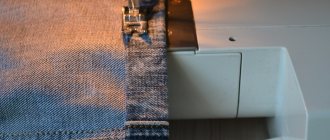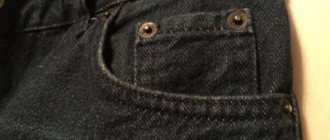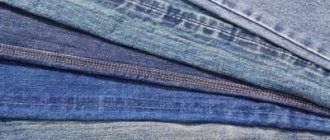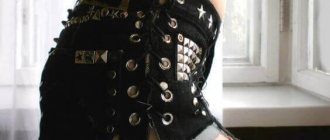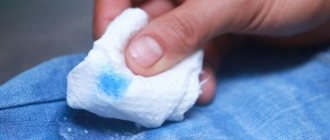Immediately after purchase, you may need to change the length of your jeans. For example, there was a desire to wear different shoes under these clothes.
You can remove excess fabric yourself, and it is not necessary to purchase a sewing machine. There are methods that allow you to shorten such a product manually using auxiliary means: adhesive tape, iron, special stitching techniques, etc.
The thing should remain attractive after all the manipulations. To this end, they are considering ways to hem jeans while maintaining the seam.
Recommendations for choosing threads and marking
When you need to cut excess fabric to length, it is recommended to visualize this process, because... understanding all the actions makes the work easier. It includes the initial stages:
- search for threads: consider durable varieties, but the thickness of the selected threads should not be thinner or, conversely, thicker than on the product itself; they should also match the color of the pants;
- Marking the material: draw chalk from the wrong side - the line should be smooth and continuous.
To make markings, use more pins/needles. First, you should put on the pants, and for this purpose, select the shoes with which you plan to wear jeans. Then you need to bend the bottom edge, for which pins or needles are used. This will allow you to determine the length of the finished product, and the inner part, which is fixed on the outside, must be cut off.
There is no need to bevel the hem line of jeans at the front.
The next step is to accurately mark the hem line on both legs. To do this, first cut off the side marked on the fitting (right). There is no need to bevel the hem line in the front and do not ask the tailor to do this, since the technology for hemming jeans does not provide for this. Next, from the mark that was made along the back of the leg, draw a line (under the ruler) parallel to the factory line of the bottom of the jeans. And most importantly, before cutting your jeans, don’t forget to add an allowance (3-4 cm) to the double hem. Often, this requires “disassembling” the factory hem, clearing the seam of thread and ironing it. You can cut jeans only after marking an additional line, with an increase for the hem of the jeans.
Preparation before cutting
When you plan to hem jeans, you immediately determine the type of shoes with which they will be worn.
Shoes, ballet flats, sneakers - all options require the use of pants of different lengths. Moreover, a few centimeters play an important role, since too short, as well as too long trousers, can ruin the whole image.
Before hemming the product, check whether the legs are the same length. This must be done during fitting. You should not take old, worn things for this purpose. In some people, due to the physiological characteristics of the formation of the bone skeleton, limbs are of different lengths. For this reason, it is important to properly trim the excess fabric from each pant leg. In this case, a difference of 1-2 cm can be significant.
Aligning both jeans legs
Half the job is already done, just one more leg of jeans left. But here, it seems, everything is simple. In fact, it is precisely in order to accurately mark the hem line on the second leg of jeans that the qualifications of a master are required. Inexpensive jeans are often sewn in semi-handicraft conditions, without particularly worrying about matching the length of both trouser legs. However. This also happens with factory tailoring. This is due to the technological features of mass production of jeans. That's why half of the jeans have different leg lengths, albeit slightly, but they do. Fold the jeans with the legs inside, align them neatly on the table, and you will see for yourself.
In order to accurately determine the hem line on the second leg of the jeans, you need, of course, to fold both trouser legs together and mark a line along the already cut-off trouser leg. It’s just that when you notice, everything seems to be perfectly straight, but when you hem the jeans and put them on, for some reason the legs of the jeans turn out to be different lengths. To avoid this, jeans folded and laid out on a flat table must be carefully aligned.
You need to check and match all the lines of the jeans: side seams, inner crotch, waistline, pockets, etc. You need to smooth out the existing wrinkles on the jeans with your hand so that there is no distortion and “wrinkles”. And only after you are sure that all the lines match, mark the second leg. To do this, you just need to draw a line with chalk along the edge of the already cut right leg. To this line you need to add (now above it) the width of the increase and mark the main line - the hem line of the jeans. This is approximately how marking the hem line of jeans is done in the studio. It’s not difficult, but without experience it’s very difficult to do it accurately, especially for some reason when jeans cost 7-8 thousand rubles.
You may not be able to mark it accurately the first time. So don't be surprised when you put on jeans. In this case, you can “disassemble” the hem and do it all over again. Well, after the first hundred jeans everything will work out perfectly.
Required tools and materials
When choosing a way to hem jeans by hand, you need to immediately prepare everything you need for this:
- scissors: choose the sharpest ones so as not to spoil the fabric;
- different types of pins: tailor's, special needles for dense materials;
- Marking tools: chalk, a piece of soap or a disappearing marker;
- threads;
- bobbin (if you plan to hem the edges of the product on a machine);
- ruler.
Who is the marginal denim style suitable for?
Marginal style in denim suits absolutely everyone, regardless of age, height and gender. The essence of style comes down to convenience and personal worldview. Such people value comfort in clothing and the need to protect the body from the cold.
Marginal denim is very popular among people of all social levels. Things that look sloppy are often made of high-quality and expensive materials. The main element of clothing in a marginal style is plain, faded, torn jeans, with patches and scuffs.
How to hem jeans without a machine
You can correct the length of your trouser legs yourself.
To manually change the crotch seam parameters without a machine, you must follow the instructions:
- When hemming jeans, you need to draw an additional line when marking. It should deviate from the first one, which was applied during fitting of the product, by 1.5-2 cm. This will allow you to properly hem the jeans and process the edges.
- The product must be cut along the bottom drawn line. If you shorten the jeans at the top band, the finished pants will be shorter.
- A fold is made, and the fabric is folded inward. The trouser legs are fixed with needles in this position - with a turn up.
- The product should also look beautiful on the reverse side. To do this, the cut edge is folded again 0.5 cm inward.
- The next stage: the needle and thread are passed from the wrong side to the front side, step back 1 cm along the edge, make a stitch, then count 1 cm forward, pass the needle again, but from the front to the wrong side. Then the steps are repeated, with each next stitch covering the gap that remains behind the needle.
Video sample of hemming jeans
In this way, you can hem jeans either by machine or by hand.
Blind seam
You can hem jeans at home using a hidden seam. It is made using vertical stitches.
- Insert the needle into the fold and then remove it.
- Pick up 2 or 3 strands of fabric.
- Insert the needle into the beginning of the stitch in the fold and bring it out from the left side at a distance of 5-7 millimeters.
- Carry out manipulations alternately on the main fabric and the fold fabric.
The thread should be in one addition. Only in this case the seam will be invisible.
How to Hem Jeans Without Cutting Them
You can shorten the product in this way manually or using a machine.
To hem jeans without errors, you should follow the instructions:
- Trying on the product. The edge is folded to the desired level (outward). These areas of material are fixed with needles.
- Hemming jeans this way is easy: make a hidden stitch under the factory seam.
- The lower part of the pants is turned inside out.
- The resulting fold must be ironed from the front side. This will give the desired shape to the product.
Step-by-step video on how to hem jeans without losing length
When you need to quickly shorten jeans, choose this option. It has the disadvantage that the inner crease appears when tight pants are hemmed.
This means that if you are choosing a way to shorten skinny jeans or another tight-fitting model, consider other of the options under consideration (with trimming the bottom edge).
"Bachelor" method
Unmarried men came up with their own quick way to shorten jeans without a sewing machine. This life hack has become popular among the fair sex. After all, thanks to him, nothing needs to be sewn. Its main feature is simplicity and originality. To do this, you must fulfill the following conditions and actions:
- iron the jeans twice to the desired length;
- the second time you need to add one centimeter;
- trim excess material;
- Using Moment glue, coat the first hem from the inside;
- carefully wrap it inside and press it, hold it for several minutes.
All similar actions are performed with the second leg. This old method helps to shorten trousers without hemming and keep them that way for a long time.
Shortening denim pants with glue
How to hem jeans while maintaining the factory seam
When the task is formulated this way, it does not mean that nothing will have to be cut off. On the contrary, in this case you can hem the jeans by first removing the factory seam.
To do this, you first need to make markings. It is enough to deviate from the factory seam by 2 cm.
Further actions:
- cut off excess fabric;
- to hem jeans while maintaining the factory seam, you need to connect individual sections (the leg and hem with the factory hem);
- make a line;
- Using an iron, the seam is given the desired shape; it must be smoothed so that protruding bumps are not visible from the front side.
Step-by-step master class
You can also make the stitching yourself. For this, the same technique is used as in the case discussed above. The seam is called a “back needle”, and each subsequent stitch is made with an indentation of 1 cm back, it covers the resulting gap.
When it is necessary to shorten pants while maintaining the factory edge, 2 parameters are taken into account: accuracy of execution, strength of the item in this area. According to these criteria, stitching done by hand is inferior to machine stitching. It is difficult for beginners and amateurs without sufficient experience to connect a pre-cut pant leg with a factory hem without defects.
Stitch seam
It is very convenient to shorten jeans using a sewn seam. How to do this correctly?
The stitch seam is made without gaps. The needle is inserted into the exit of the previous stitch. The direction of the seam is from right to left. The thread should be in the middle.
- Insert the needle to the right of the thread at a distance of 5 millimeters.
- On the left, bring it out at the same distance. You will get a beautiful stitch.
- After this, insert the needle into the beginning of the stitch. Output 5 millimeters to the left of the thread.
For the length of breeches or shorts
For these purposes, you can choose any out-of-fashion jeans that fit your figure well. For knee-length breeches, both tapered and straight models are suitable. It is good to use stretch and natural cotton jeans at the same time.
Important points when cutting jeans to shorts length:
- for classic and short shorts, it is better to use only natural denim, since elastic fabrics pinch the thigh, which does not look aesthetically pleasing;
- when planning the length, it is better to leave an extra 2 cm and then cut it off if necessary, rather than immediately cutting it too short;
Work order:
- Selecting product length. When planning hems or cuffs, an allowance of approximately 7 cm is left. If fringe is planned, an allowance of at least 2 cm is left. Appropriate markings are applied with a pencil.
- Using sharp scissors, cut to the required length, taking into account allowances.
- The product is being tried on. A decision is made to process the bottom. Perhaps, when trying on, the desire to make a fringe will change to a desire to bend the bottom of the product or make a lapel. Depending on the decision, the length of the shorts or bridge is adjusted.
- The bottom of the product is processed.
Bottom processing options may vary:
- With a lapel. The bottom is turned over twice to the front side of the product, the bend of the desired width is fixed with a steam iron.
- With a hem. The lapel is made inside the product and stitched on a sewing machine or with a hand stitch.
- With fringe. Fringe can be obtained in different ways. You can rub the edges against each other, imitating the motion of hand washing.
You will get a light, neat fringe. Also, by pulling the threads with tweezers, you can get a longer, stylish fringe. This creates a more natural, messy look with a jagged edge. Washing in the machine also gives a good result in creating a fringed edge.
Preparatory work
When transforming your favorite jeans, your body shape and season trends are taken into account. The most important step when cutting jeans is to accurately determine the desired length of the product.
Preliminary steps to be performed before starting work:
- The style in which cropping is expected is determined. Viewing photos on the Internet and studying the characteristics of your own figure will help you make the right choice.
- Selected jeans are pre-washed. Natural denim shrinks slightly after washing. If you cut off unwashed, worn-in jeans and then wash them, you can get a result that differs from what was originally intended. For example, the length of the product and the length of the fringe will become shorter.
- The necessary tools are being prepared.
- The desired length of the trouser legs is determined in front of the mirror and a mark is made with a pencil or chalk.
How to cut denim at the bottom in a fashionable way? Options and step-by-step description Season trends suggest current solutions for creating fashionable jeans, shorts and breeches.
